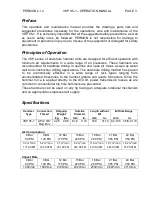
PERMON s.r.o. VKP 95-1 – OPERATION MANUAL PAGE 6
Lubricate the bit splines. Place chuck over bit followed by O-ring and split ring. Check
that both parts of the split ring are positioned number to number and that the serial
numbers are the same.
Screw the chuck/bit assembly into the cylinder hand-tight before using power make-
up.
Tighten the hammer securely to the drill pipe by applying a wrench to the flats of the
hammer’s backhead and rotate slowly using the rig’s rotational action.
Insure the lubricator is working properly and has fully coated the drill pipe ID.
Lower the hammer slowly until the bit contacts the rock and the piston starts
operating.
Important: Wear gloves at all times when guiding the hammer into the hole to
protect hands. Follow all safety precautions.
When drilling a new hole, add just enough hold-down pressure to start breaking rock.
When drilling through loose surface material, avoid running the hammer at high air
pressures as this will tend to blow the hole apart.
After a few feet of drilling, increase the total weight on the bit until the hammer runs
smoothly. The air pressure will rise slowly, then stabilise.
Caution: Always apply the air and start rotation before putting weight on the bit to
avoid damaging the bit.
Additional weight on the bit will not appreciably increase the penetration rate, but will
lead to greater carbide and hammer wear.
Lubrication
Correct lubrication during drilling operations is extremely important. Inadequate
lubrication is a major cause of hammer wear and failure. Use rock drill oil only.
When new VKP 95-1 DTH hammer or drill pipe are put into use, it is recommended
that 1/4 a quart (0.25 ltrs) of oil be pured into the new hammer or each pipe to give
them a good coating of oil and to prevent the hammer from running dry at any time.
The recommended amount of rock drill oil for reliable operation 0.08 quarts per hour
per 100 CFM (0,15 litres per hour per m
3
/min).
Check oil levels each shift. Monitor oil delivery to hammer by looking at oil dripping
from bit after each hole is drilled.
Hammer will not be damaged by too much oil. It can be damaged by not enough oil.









